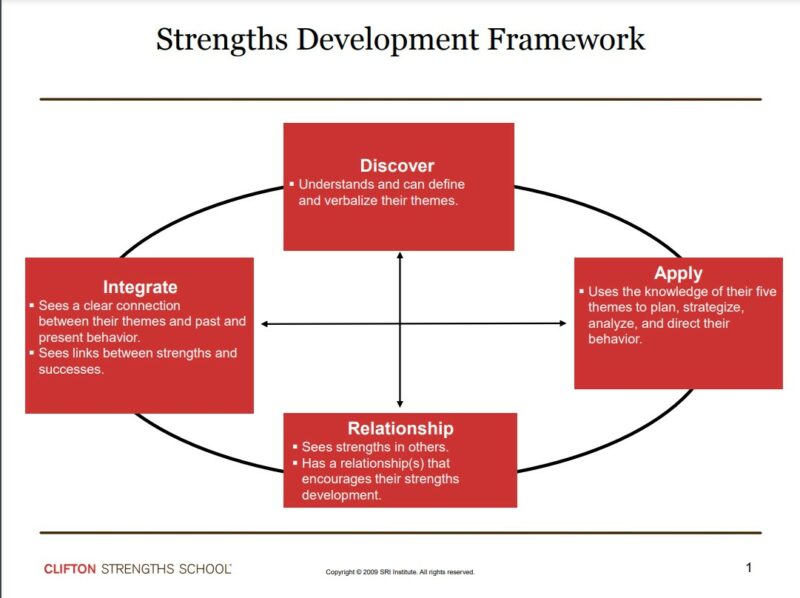Here at WT, students complete the CliftonStrengths for Students assessment, usually as part of their onboarding process as they enter the university. This Gallup-owned assessment helps individuals identify their Top 5 Signature Themes from among a list of 34. Next, these 34 themes or talents are further categorized into the domains of executing, influencing, relationship building and strategic thinking.
What are CliftonStrengths?
Gallup defines talents as “naturally recurring patterns of thought, feeling, or behavior that can be productively applied.” The idea behind the assessment is that students can be more self-aware of their individual strengths and abilities by identifying their Top 5 Signature Themes. This self awareness can inform how they approach their time and efforts here at WT and their future career.
According to Gallup, use of CliftonStrengths at work leads to more engagement, confidence, and quality of life. For college students, self-awareness of one’s Top 5 Themes can help students discover passions or put existing ones into context, and even aid in developing self-confidence and social intelligence. The Strengths Development Framework identifies this as a process of discovery, application, identifying relationships, and integration of strengths and successes.

Here at WT, this process of self-discovery via CliftonStrengths doesn’t have to be limited to students. For example, many faculty and staff at WT have taken the assessment as well. In fact, I recently had an interesting insight about how one of my pedagogical (that is, teaching) strategies reflects my Top 5.
My Top 5 Strengths
To put my results in context, my Top 5 CliftonStrengths are Individualization, Input, Learner, Intellection, and Empathy. An interesting feature about my Top 5 is that the middle three all come from the assessment’s Strategic Thinking domain. Meanwhile, Two themes from the Relationship Building domain bookend these, meaning all my Top 5 come from these two domains.
In other words, I like to learn and think about a variety of topics. I also care a lot about people’s individual needs and how teams can come together. In hindsight, perhaps this explains how I came to pick an academic discipline that allows me to learn about people and relationships to each other and with the media (media communication)!
Pinterest and Teaching
As my previous students can attest, I really enjoy using Pinterest boards. I use them while teaching to share current events and interesting things I find online with my students. Early in my teaching days, I used to send these finds as emails, but that quickly felt excessive. Plus, it just looked clunky.
Then, I discovered it was possible to embed a link to a Pinterest board within our course learning management system, WTClass. The link displays a live preview of sorts of what the board looks like, which I personally find more appealing than a plain text-based link.
These days, I curate Pinterest boards for the major topic areas I teach in, including advertising, IMC, and business communication. As I’m online, whenever I see something that catches my eye, I just pin it to the relevant board(s). Now, instead of sending my students lots of emails that, let’s face it, they probably won’t all read, I can share with them a curated, evolving collection.
Student can return to over time, even after the semester ends if they bookmark the link to the board. I get to share all the tidbits that fascinate me about the topic we are studying together that semester. Students can review what is of interest to them without getting swamped in emails from me.
In some semesters, I’ve even asked students to participate in curating a class-specific board. I recently wrote about that process for the Journal of Advertising Education. The research results I found suggest this kind of use of Pinterest is supportive for collaborative learning in online course environments. (You can access a read-only, open access version of this journal article here).
Connecting the CliftonStrengths Dots
So, what’s the connection between using Pinterest and my CliftonStrengths? Well, I recently had a mini-epiphany about that. My love of using Pinterest boards to share information with my students reflects my first two Top 5 Strengths in action.
As previously mentioned, my first two CliftonStrengths are Individualization and Input. People with the Individualization strength are intrigued by the uniqueness of individuals. Meanwhile, folks strong in Input like to collect and archive information, ideas, and so on.
Next let me explain the connection. Firstly, people strong in Input love to collect and archive. And what else is a Pinterest board but a visual archive of Internet links? Secondly, people strong in Individualization care about the unique qualities of each person. One of the things I enjoy about this method is each student can take something unique from these resources by choosing what they want to focus on. I’ve even been known to seek out and share resources based on specific student questions I receive.
CliftonStrengths in Learning and Teaching
In summary, faculty here at WT care a great deal about student learning and developing effective instruction to meet our students’ needs as future professionals.
Still, it was fun for me to newly discover how my individual CliftonStrengths can work to support this educational mission.
This realization is an example of the Strengths Development Framework in play. I integrated my themes with my current practices at work through a process of self-reflection. This is the ongoing learning process all who use CliftonStrengths can undertake. We can refine and learn about what unique skills we bring to our workspaces to benefit our colleagues and communities.
Now, at the beginning of the summer, is a great opportunity for students (or faculty and staff!) to spend a little time learning more about your own unique Top 5 CliftonStrengths. You can learn more about CliftonStrengths in the video below. (Bonus: Students in the COB’s Media Minds organization made this video in a previous academic year!)
Additionally, WT also offers a variety of resources and activities to help students practice and develop their skills in light of CliftonStrengths. You never know what insights about yourself you might uncover!
Dr. Heidi Huntington
Assistant Professor of Business Communication


